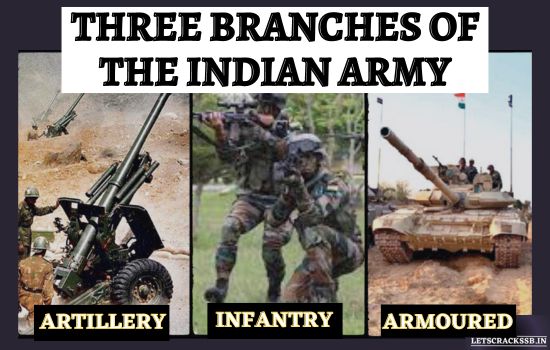Infantry Armoured and Artillery: Decoding the Indian Army and Unraveling their distinct roles
The Indian army is one of the 4th strongest and one of the most formidable military forces in the world. With its valorous records and diverse skills, the Indian army operates via diverse regiments. Every regime has its own importance with specific roles and responsibilities. In this article, we can explore the class of the Indian army and explore the unique capabilities of Infantry Armoured and Artillery regiments. By understanding the unique contributions of each regiment, we can gain a deeper gratitude for the complexity and effectiveness of the Indian Army as a whole.
Classification of the Indian Army
The Indian army can be broadly categorized into three predominant classes: Infantry Armoured and Artillery regiments. These regiments form the backbone of the Indian army and work in tandem to ensure the country’s safety and protection. Whilst each regiment has its very own specialized function, they all support the common purpose of protecting the sovereignty and territorial integrity of India, not only on the borders but inside the country when needed.
Infantry Regiments of the Indian Army and Their Role
Infantry regiments are the foot soldiers of the Indian army and are in most cases responsible for direct combat with the enemy. Equipped with a wide range of weapons, from rifles to machine guns, infantry units are trained to operate in various terrains and weather conditions. They are often the first to be deployed in conflict zones and play a crucial role in capturing and holding ground.
Infantry regiments are trained in both offensive and defensive tactics. In offensive operations, they are responsible for launching assaults and seizing enemy positions. On the other hand, in defensive operations, they fortify their positions and repel enemy attacks. Infantry units also play a vital role in counter-insurgency operations, maintaining law and order, and providing humanitarian assistance during natural disasters.
To know more about Infantry regiments – do check out our earlier article – All about Infantry Regiments of the Indian Army
Armour Regiments of the Indian Navy and Their Roles
Armour regiments of the Indian army are tasked with supplying mobility, firepower, and safety on the battlefield. They’re ready with armoured vehicles, including tanks and personnel carriers, which enable them to operate effectively in various combat scenarios. Armour regiments are often deployed in armoured formations, which consist of multiple tanks and supporting vehicles.
The primary role of armour regiments is to engage and destroy enemy armoured formations. Tanks, with their effective guns and thick armour, can penetrate enemy defences and provide cover to infantry units. In addition, they play a crucial role in breakthrough operations, where they spearhead the assault and create openings in enemy lines. Additionally, armour regiments are used for reconnaissance, creating obstacles, and providing fire support to other units.
Artillery Regiments of the Indian Military and Their Roles
Artillery regiments form the long-range firepower of the Indian Army. They’re responsible for delivering the correct and suitable devastating firepower onto enemy positions. Artillery units encompass various forms of weapons like howitzers, and rocket launchers, capable of engaging targets at different ranges and with different types of ammunition.
The main role of the artillery regiments is to offer indirect fire assistance to the infantry and armour units. They could soften the enemy’s defences before any attack, suppress enemy fire throughout an assault, and provide non-stop support during the battle. Artillery units are also used for counter-battery fire, neutralizing enemy artillery positions, and carrying out strategic moves deep into enemy territory.
The fundamental distinction between Infantry Armoured and Artillery Regiments of the Indian Army
Whilst all three regiments are critical and essential components of the Indian army, they differ in their roles and competencies. Infantry regiments are mainly responsible for engaging the enemy in direct fighting, either offensively or defensively. They operate on foot and are trained for various terrains and situations.
Armour regiments, on the other hand, are equipped with armoured vehicles and specialize in imparting mobility, firepower, and safety on the battlefield. Tanks are their number one weapon, allowing them to interact and spoil enemy armoured formations effectively.
Artillery regiments, with their long-range firepower, provide indirect fire support to infantry and armour units. They engage enemy positions from a distance and can deliver devastating firepower onto the battlefield.
Infantry Armoured and Artillery – When Are these Regiments suitable at the maximum?
The suitability of every regiment depends on the specific necessities of the battlefield and the nature of the conflict. Infantry regiments are most appropriate for operations in rugged terrains, dense forests, and urban environments. Their ability to operate on foot and adapt to various situations makes them effective in these challenging conditions.
Armour regiments excel in open terrains, such as deserts and plains, where their mobility and firepower can be fully utilized. They are particularly effective in offensive operations and breakthrough assaults, where they can create openings in enemy lines and support infantry units.
Artillery regiments are suited for any type of terrain and can be deployed in various combat scenarios. Their long-range firepower makes them highly versatile and adaptable to different situations. They are often used in conjunction with infantry and armour units to provide continuous fire support throughout the battle.
The Infantry Armoured and Artillery regiments of the Indian army form the foundation of its combat capabilities. Each regiment plays a unique and crucial role in ensuring the defense and security of the nation. By understanding the distinct functions of these regiments, we can appreciate the complexity and effectiveness of the Indian Army as a whole. Their dedication, training, and commitment to duty make the Indian Army a force to be reckoned with on the global stage.
Also Read
- Why do Military Vehicles have Unique Number Plates?
- What is the Structure of The Indian Army? || Formation of the Indian Army
- SSB Interview the Complete Guide | Let’s Crack SSB
Are there any other regiments in the Indian Army apart from Infantry Armoured and Artillery?
Yes, other than the Infantry, Armour, and Artillery, the Indian army additionally has regiments specialized in Engineering, Signals, Aviation, and different support functions. These regiments play a vital role in providing essential services and support to the combat units.
How are soldiers assigned to different regiments?
Soldiers are assigned to different regiments based on their training, specialization, and the needs of the Indian Army. They undergo rigorous selection and training processes to ensure they are suited for their respective regiments.
What is the role of regiments in peacetime?
In peacetime, regiments of the Indian Army are responsible for training, maintaining readiness, and conducting various exercises. They also play a role in community outreach programs, disaster management, and providing assistance during national emergencies.


